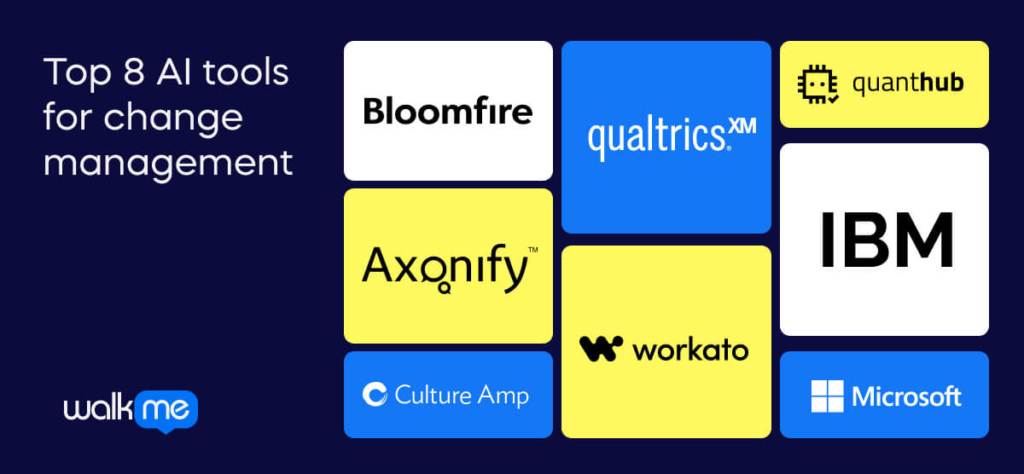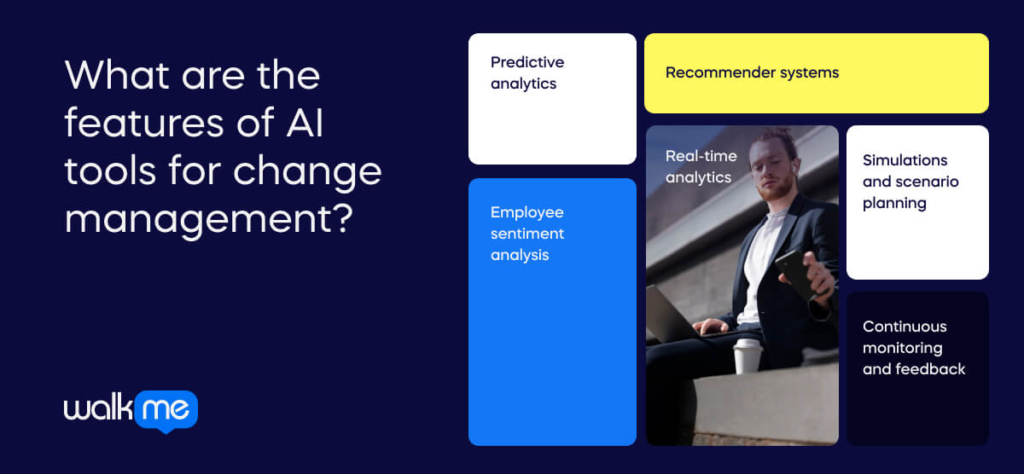Change management is complex. Using the right digital tools is the only way to help your staff navigate it.
An artificial intelligence (AI) change management app portfolio should be extensive. It should include predictive analytics. It will also have employee sentiment analysis, real-time monitoring, and personalized recommendations. These many features ensure good choices and worker involvement. They help throughout the change.
22% of change managers use AI every day. They use it to optimize their support for their clients.
Combining human soft skills with AI tools is crucial. Using AI tools is vital today to stay on top of change management.
Check out the top 8 AI tools for change management. See their key features. Use them to get the most from each AI-powered change management tool. You invest in them. They revitalize your digital transformation.
Top 8 AI tools for change management

Using AI in change management is crucial. It lets organizations use data-driven insights for informed choices. It helps them expect challenges. It boosts employee engagement. AI augments human abilities. It makes transitions smoother and outcomes sustainable during change.
G2 ratings guide our selection, providing impartial evaluations by compiling user reviews and social media input.
Please also bear in mind that a higher rating doesn’t necessarily mean a higher position. We evaluate each review based on factors like quantity and score combinations.
So let’s kick off the list with Bloomfire, an information-sharing app.
- Bloomfire
- Review Rating: 4.6/5
- Ease of Use: Excellent
- Effectiveness: Excellent
- Pricing: See the website
Bloomfire is a knowledge-sharing platform that enables teams to centralize, organize, and share information to make it easy to access for each knowledge worker. It works by allowing users to create and collaborate on content. Businesses utilize it to improve knowledge management. Its uniqueness lies in its intuitive interface and robust search capabilities.
- Axonify
- Review Rating: 4.7/5
- Ease of Use: Excellent
- Effectiveness: Excellent
- Pricing: See the website
Axonify is a micro-learning platform that delivers personalized training to employees. It provides bite-sized content and reinforcement activities to drive knowledge retention and behavior change. Businesses use the app to improve employee performance and compliance. Its uniqueness lies in its adaptive learning algorithms and gamified approach to training.
- Culture Amp
- Review Rating: 4.5/5
- Ease of Use: Excellent
- Effectiveness: Excellent
- Pricing: See the website
Culture Amp is an employee feedback and analytics platform that measures and improves company culture. It gathers feedback through surveys and analyzes data to identify trends and areas for improvement. HR departments utilize Culture Amp to create a positive workplace culture. Its uniqueness lies in its focus on culture analytics and actionable insights.
- Qualtrics Employee XM
- Review Rating: 4.5/5
- Ease of Use: Excellent
- Effectiveness: Good
- Pricing: See the website
Qualtrics Employee XM is an employee experience management platform that collects feedback through surveys and sentiment analysis. It works by providing actionable insights to improve employee engagement and retention. HR departments use it to create a positive work environment. Its uniqueness lies in its customizable surveys and real-time analytics.
- Workato
- Review Rating: 4.7/5
- Ease of Use: Excellent
- Effectiveness: Excellent
- Pricing: See the website
Workato is an integration platform that automates workflows across various applications. It enables users to connect disparate systems and streamline processes. Businesses of all sizes utilize Workato to improve efficiency and productivity. Its uniqueness lies in its user-friendly interface and extensive library of pre-built integrations.
- QuantHub
- Review Rating: Unrated
- Ease of Use: Excellent
- Effectiveness: Excellent
- Pricing: See the website
QuantHub is a data science and analytics platform that provides training and assessments. It works by offering courses, challenges, and certifications in data-related skills. Individuals and organizations use QuantHub to upskill and reskill in data science. Its uniqueness lies in its hands-on learning approach and industry-aligned curriculum.
- IBM Watson
- Review Rating: 4.4/5
- Ease of Use: Excellent
- Effectiveness: Excellent
- Pricing: See the website
IBM Watson is an AI-powered platform that analyzes data to generate insights and recommendations. It works by processing vast amounts of structured and unstructured data. Enterprises across industries utilize it for decision support and predictive analytics. Its uniqueness lies in its cognitive computing capabilities and ability to understand natural language.
- Microsoft Viva Glint
- Review Rating: 4.7/5
- Ease of Use: Excellent
- Effectiveness: Excellent
- Pricing: See the website
Microsoft Viva Glint is an employee engagement platform that gathers feedback through surveys and sentiment analysis. It provides insights to improve employee experience and retention, and HR departments use it to enhance workplace culture. Its uniqueness lies in its integration with Microsoft Teams and other productivity tools.
What are the features of AI tools for change management?

Harnessing AI-driven data insights can profoundly transform decision-making in change management endeavors amidst digital transformation.
Employing AI algorithms and sophisticated analytics techniques empowers organizations to glean invaluable insights from vast and intricate datasets, facilitating more efficient and informed decision-making throughout the change management journey.
Below are several ways AI-driven data insights can bolster decision-making within change management.
Predictive analytics
Through analyzing historical and real-time data, AI can discern patterns and trends, enabling organizations to forecast potential hurdles, resistance, or areas of success in the change management process.
This predictive capability equips decision-makers to anticipate challenges and devise proactive strategies to mitigate risks, maximizing the likelihood of success.
Employee sentiment analysis
Leveraging AI-powered sentiment analysis allows assessing employee attitudes, emotions, and perceptions toward change initiatives.
By scrutinizing data from diverse sources such as surveys, social media, and internal communications, AI can furnish insights into employee sentiment, pinpointing areas necessitating additional support or intervention.
With this knowledge, decision-makers can tailor change management strategies to address specific concerns, fostering heightened employee engagement and buy-in.
Recommender systems
Recommender systems employ algorithms to analyze user preferences and behavior, generating personalized recommendations for products, services, or content. They utilize data such as past interactions, ratings, and demographic information to predict users’ preferences and suggest relevant items.
These systems are utilized across various industries, including e-commerce, streaming services, and content platforms, to enhance user experience and drive engagement.
In AI change management tools, recommender systems play a vital role in providing tailored recommendations for resources, training programs, or best practices to employees. These systems offer personalized guidance to facilitate adaptation to change initiatives by analyzing individual skill sets, roles, and needs.
Recommender systems aid organizations in optimizing their change management strategies by ensuring employees have access to the most relevant resources and support. This support enhances their effectiveness and drives successful outcomes.
Integrating recommender systems into AI change management tools empowers organizations to leverage data-driven insights for more targeted and impactful interventions, ultimately fostering smoother transitions and sustainable transformations.
Real-time analytics
Artificial intelligence (AI) enables organizations to conduct real-time data analysis, providing decision-makers with immediate insights into the progress and impact of change initiatives.
Through real-time analytics, organizations can identify bottlenecks, assess the effectiveness of interventions, and facilitate agile decision-making processes.
This capability empowers organizations to adjust and optimize their change management strategies swiftly as needed, ensuring they remain responsive to evolving circumstances.
By leveraging AI-driven insights, organizations can enhance their ability to navigate complex change processes effectively, leading to smoother transitions and improved outcomes.
Integrating AI technologies into change management practices underscores the importance of leveraging data-driven approaches to drive organizational success in today’s dynamic business environment.
Simulations and scenario planning
Organizations can use AI-driven simulations to simulate diverse scenarios and their potential consequences, allowing decision-makers to assess the impact of various change management strategies before implementation.
Organizations can evaluate each approach’s risks and benefits by simulating alternative scenarios, facilitating data-driven decision-making grounded in likely outcomes.
This capability empowers organizations to make informed decisions and mitigate risks effectively, ensuring smoother transitions and successful change management initiatives.
Continuous monitoring and feedback
AI-powered monitoring systems can gather and analyze data about change initiatives. They give decision-makers real-time feedback on progress, adoption rates, and areas needing attention.
AI-driven data insights can help organizations make better decisions. They can also anticipate challenges, boost employee engagement, and drive successful change management.
This fusion of AI and human intelligence fosters a more agile, effective, and adaptable change management process, facilitating smoother transitions and sustainable digital transformation outcomes.
Include a range of features in your AI change management portfolio
Change is complex, and resistance is always present. You need many tools for your change management toolbox. They help staff see the benefits of change. They make each change succeed.
A full AI change management portfolio should include predictive analytics. It should also include employee sentiment analysis. It should also have live monitoring. It should also offer personalized suggestions.
Adding these skills helps organizations. It can improve decision-making. They can also boost employee engagement. They can also navigate digital changes. They can do so quickly. This approach ensures they have lasting growth. It gives them an edge in today’s fast business world.

